Buying A Commercial Helicopter
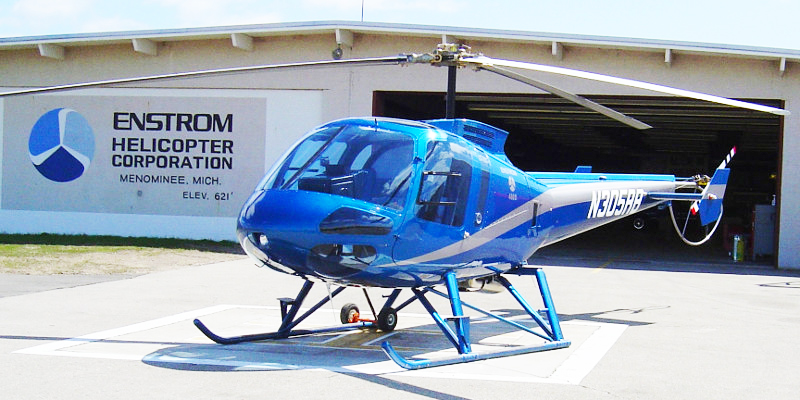
The author of the following article, in addition to being the publisher of this magazine, is also the president and principal stockholder of the Enstrom Helicopter Corporation of Menominee, Michigan.
Because of these circumstances, no direct comparisons between the various helicopters discussed in this article will be drawn, since despite the most scrupulous effort toward absolute objectivity in evaluation, the inference of bias in favor of the Enstrom would remain ineradicable.
This is, rather, an attempt to familiarize the public generally with the advantages and the realities of helicopter ownership and use. Only a small minority of Americans have ever ridden in a helicopter, and only a tiny minority have ever flown one. Most people view these mystical birds with a mixed look of awe and suspicion.
Because there are strong indications that in the 1970s helicopters are going to enjoy increasingly widespread use, some understanding of the basics involved may help potential buyers (most of whom do not know that they are potential buyers) reflect upon the prospect of use in an informed manner.
The only product comparisons which are drawn—operating costs—are those furnished by the manufacturers themselves. The author is an active pilot with more than 20 years and 8,000 hours experience. He flies helicopters, light and medium propeller-driven airplanes, and jets on a regular basis, and prior to assuming control of Enstrom two years ago was president of the Brantly Helicopter Corporation.
The butt of more cartoonist humor than could reasonably be counted up has long been that inexorable and bearded swami of the Middle East who glides effortlessly along on what seems to be a small, medium-priced Oriental rug. Its powerplant, aerodynamic properties, and general performance envelope are never disclosed. But in a way, we all wish we had one.
If we spend much time going to and from in bumper-to-bumper, smelly, maddening, appointment-frustrating road traffic, we wish that we had one very much. I reluctantly report that there are no companies in the world now building operable magic carpets, and none are on the drawing boards.
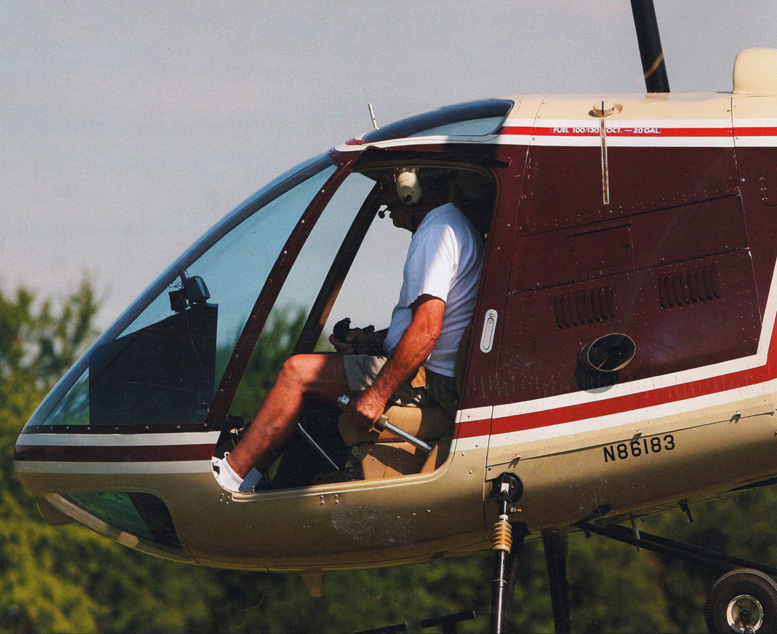
But for those who would enjoy the consummate luxury of moving from place to place on this earth in completely unfettered form, there is a reasonable substitute: the Enstrom helicopter. Larger, noisier, and more expensive than a magic carpet, it is also safer and more comfortable.
I mean, really, whoever saw a flying carpet with an enclosed and heated cabin, or one that could take a complete power failure and then glide gently to a full-stop landing?
Not even the cartoonists went that far. Way back in 1946 (was I alive then?) when Bell won the first certification for a true civil helicopter, men of imagination and enthusiasm earnestly predicted that there would soon be an “eggbeater” in every backyard.
The notion of skipping from one spot to another was initially attractive, and still is; but the predictions were premature. There are at the moment only 4,185 helicopters registered in the United States, which represents something less than one per family. Still, this shows an increase of 2,688 since this time in 1963, which is statistical progress.
There is good evidence that the number of registered ships may accelerate and even proliferate between now and the end of the decade. Conservatively projected, therefore, helicopters will serve many swingers and most winners (including all swingers who are winners) in the next few years.
Hence this article. There is little public ignorance about the fact that a helicopter is a unique piece of equipment. Thanks in part to whatever it was that occurred in Vietnam, choppers are no strangers on the American scene.
About almost every other facet of the helicopter, ignorance is abundant and occasionally, I am sad to say, masked with authority. The rumors outnumber the facts. Being the devil’s advocate (he has never in fact been a client) I must report to you that helicopters are reputed to have some terrible disadvantages, to wit:
(1) They are very expensive to buy.
(2) They are horribly expensive to operate and maintain.
(3) They make unbearable noise.
(4) They are dirty to own or ride in.
(5) If the engine quits, they fall out of the sky—thus condemning to eternity all aboard.
(6) Rotor blades often fly off, with the same discouraging consequence.
(7) They are so difficult and tricky to fly that only those of great muscular co-ordination and superior intellect can manage to keep them upright.
There are other scandalous remarks that emanate from the uninformed, but these are the most often heard. Since these assertions are by and large straight bullshit, your completion of this treatise will lift you from the ranks of the ignorant and enable you to respond in learned fashion to any future bullshit you may encounter.
The helicopter (“whirlybird,” “egg – beater,” “chopper,” or Helico-Peter, as it is variously called) is unique among aircraft in one most important respect: It can land and take off vertically in a space little bigger than the diameter of its own rotor blades.
Although it is frequently compared to an airplane as a transportation tool, it is in fact a substitute for the automobile in actual use. For most people traveling two hundred miles or so, it is the fastest means of point-to-point transportation available, as compared with any combination of other vehicles.
In addition, it is virtually exempt from traffic of any sort. It flies just over the tangled highways and metropolitan streets, and well below the snarls and holding patterns of fixed-wing airplanes. This latter feature of helicopter travel accounts for one of its most gratifying aspects: predictability.
For whereas arrival time is usually difficult, or impossible, to estimate with certainty when surface or conventional air transportation
is used, the helicopter flier need only take into account the en route winds and he can declare his destination touchdown precisely, give or take a minute or so.
Other than a few extreme weather conditions (very low ceilings and/or forward visibility, or freezing rain) there is nothing to inhibit or interrupt a straight-line path, from lift-off to landing.
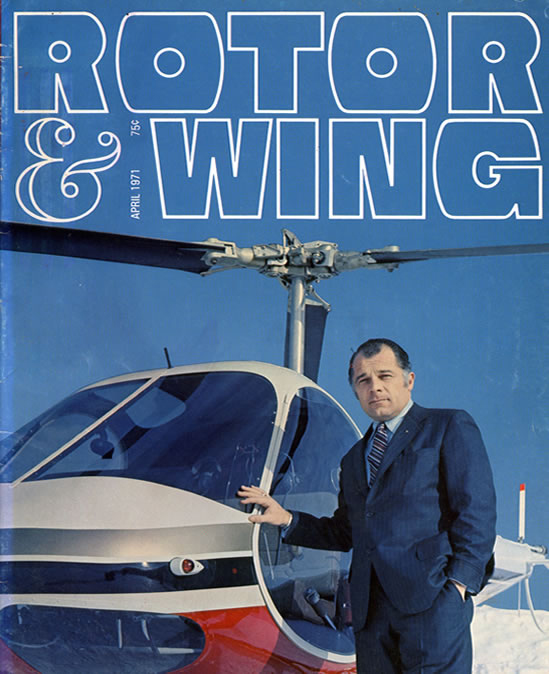
When certification for instrument flight becomes more common, even the foulest weather will present no obstacle, for helicopters (as the military has often demonstrated) can take off and land in near zero-zero conditions. What is it like to own and live with a helicopter as a personal vehicle on a daily basis?
Well, there are difficulties, none of which are insurmountable, and delights, some of which are all but indescribable. But primarily, there is an efficiency about the whole experience which, once tasted, is as difficult to forget as Beluga caviar or Royal Salute Scotch.
If the helicopter is nothing new, it is not so very old, either. For although people were experimenting with rotorcraft seriously at about the time the Wright Brothers were at Kitty Hawk, the first four decades did not produce a marketable machine.
The legitimate father of the helicopter industry was the recently deceased Igor Ivanovitch Sikorsky, whose VS-300 machine first flew in 1939, and was accepted by the military for production shortly thereafter. The first civilian helicopter to be certificated by the Civil Aeronautics Administration (now the FAA) was the Bell model 47 in 1946.
This ship, with its globular bubble cabin, exposed engine, and steel tubing framework fuselage is the popular image of the civil helicopter even today; in fact, a considerably refined version of the Bell 47 is still in production.
During the past quarter-century the names of Sikorsky, Bell, Hiller, Boeing, Piasecki, and Kaman, and more recently Brantly, Hughes, and Enstrom, have dominated the American world of helicopters.
Of these, only three companies are currently producing “persona!” helicopters (priced under $200,000): Bell, Hughes, and Enstrom. Also available to the buyer, however, are three models built by the Anglo-French conglomerate Aerospatiale and marketed in this country by Ling-Temco-Vought.
It is to this “personal” group (one engine, three- to five-place) rather than to the giant Boeing and Sikorsky passenger-haulers and aerial cranes that the discussion below will be limited. First, what’s available? Well, the “personal” group (shall we dub them “Swinger-Choppers?”) should actually be divided into two separate categories:
- piston-powered, three-place machines costing from 45 to 60 Gs and cruising from 80 to 100 miles per hour; and
- turbine-powered, five-place ships costing in excess of 100 Gs and cruising from 110 to 160 miles per hour.
Of the lower-priced type there are three: the Bell 47, in several versions including one supercharged machine for high-altitude work; the Hughes 300 and 300C; and the Enstrom F-28A and 280.
In the upper range, there is the Hughes 500, the Bell 206B JetRanger, and the three entries from Aerospatiale: the Alouette II; the Llama (actually an Alouette II fitted with a larger engine); and the SA-341 Gazelle. While all of these helicopters have many things in common, there are some pointed differences which must be taken into account, depending upon the kind of use planned.
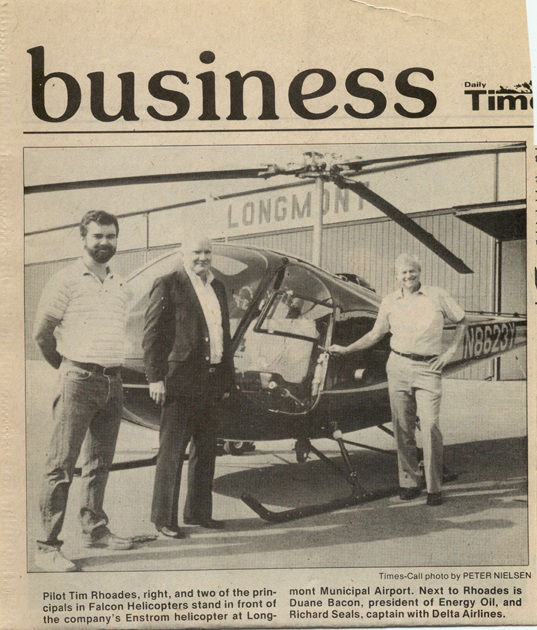
Each machine has certain basic components: a rotor system, consisting of two, three, or four “wings” turning on a vertical shaft to provide lift; a powerplant, to turn the rotor system, either piston or turbine; and an antitorque or “tail” rotor to afford directional control while offsetting the tendency of the airframe to turn in a direction opposite to the “wings,” or main rotors.
Similarly, each of these ships has the same basic control system: a cyclic stick, to control the tilt of the “rotor disc” formed by the spinning main rotors; a collective pitch stick, to increase or decrease the angle of the main rotor blades and thus control the amount of lift; a throttle of the motorcycle variety (actually a twist-grip control located on the collective) to control engine power; and foot pedals to vary the pitch of the tail rotor. If this sounds like a handful, it is not.
Indeed, during most phases of flight one hand and both feet have virtually nothing to do, which is one limb better than is required by an automobile cruising a highway in light traffic (unless, of course, you have automatic speed control).
To understand the manner in which a helicopter “works,” it is necessary to conjure up an image of the spinning rotor disc. This disc is in reality the main rotor blades, powered by the engine, turning about the driveshaft.
Depending on the design of the ship, the rotor shaft will turn more than 300 and less than 500 times per minute, and as to any given helicopter the allowable variance will be slight—no more than, say, 20 to 30 rpm.
Once the main rotors are brought to operating rpm for takeoff, that rpm is held until the flight is completed. Changes in power are strictly the result of correlated movements of the collective stick and the throttle.
After the main rotor blades are spinning up, and the rotor disc is established, it is kept level (or parallel to the surface) with the cyclic stick. As the collective is slowly raised, more power is fed to the engine by a cam or bellcrank device which automatically opens the throttle without twisting the grip.
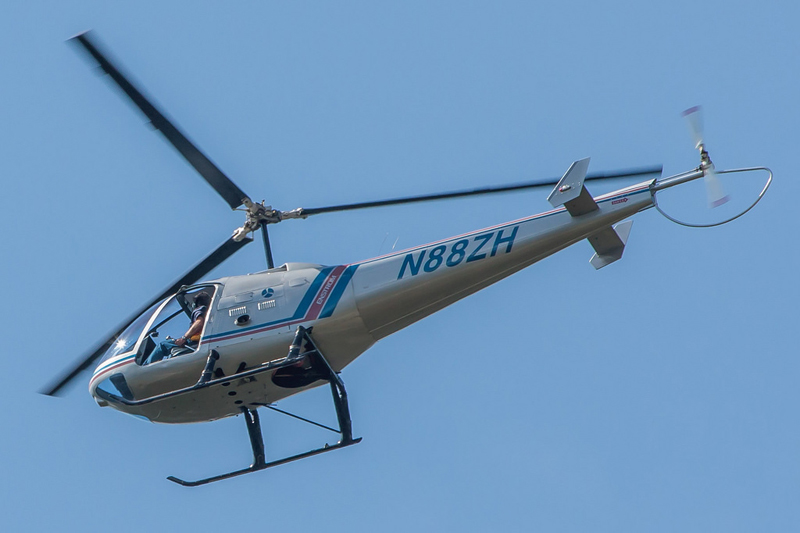
Raising the collective on the Enstrom helicopter increases the pitch of all the main rotor blades at once, giving them a bigger “bite” of the air in which they twirl, and increasing the lift developed by the rotor disc.
At the same time, the pitch of the tail rotor is increased with a foot pedal (on all U.S.- built helicopters, the left pedal; on the Aerospatiale models, the right one) in order to neutralize the increased torque created by the engine and rotor system.
When the amount of lift developed exceeds the gross weight of the ship, it picks itself up to a hover. A very slight decrease in collective pitch, and it stops rising, hanging comfortably in the air with all forces in equilibrium.
The beginning student is first taught to control the ship in a hovering condition. Movement in any direction (forward, to the rear, or to either side) is accomplished by moving the cyclic stick in the desired direction of travel.
This in turn tilts the rotor disc, moving the ship in the direction of tilt. Directional changes are accomplished with the feet, increasing or decreasing the pitch of the tail rotor. For hovering flight, that’s about all there is to it.
For takeoff (that is, to go somewhere) it is only necessary to transition from a hover to forward flight. The machine is first picked up two or three feet to a hover, pointed in the desired direction of departure, and then moved out by tilting the rotor disc forward while feeding in more power with the collective. At this point the phenomenon of lift comes into play. This is a difficult phenomenon to explain, but we know it’s there.
“Ground effect,” a much simpler phenomenon, occurs when a helicopter hovers close to the surface. The ground retards the downward flow of air from the rotor. The effect of the ground is to “cushion” the aircraft, giving it more lift than it would otherwise develop. As the helicopter moves at more than a crawl in any direction, it tends to leave this ground cushion behind, and thus requires more power to hold its altitude.
As the ground cushion is lost, however, “transitional lift” comes into play. At about twenty miles per hour of forward airspeed, and with no change in power, the ship will quite noticeably begin to climb.
Without sampling the several theories as to why this occurs, suffice it to say that it does and you can count on it. The fact of “translational lift” offers two interesting opportunities to the helicopter operator.
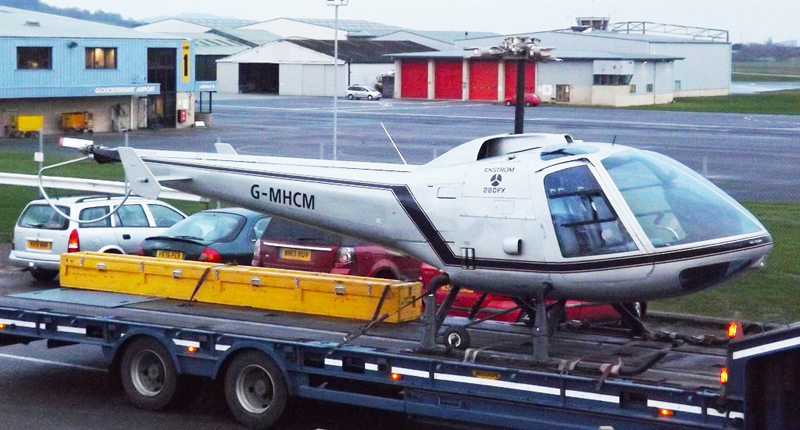
First, and when heavily loaded, it may be possible to take off into a wind under circumstances where the ship lacks the power to hover in calm air.
Second, where the wind is light, it is possible to slide the helicopter along the ground (on its wheels, skids, skis, or floats) to a speed where the combination of oncoming wind and sliding speed reaches twenty miles per hour, and it will lift off. Accomplishing takeoffs (and landings) of this type is part of every student’s training.
Aha! I can hear the question building now: “What’s this stuff about moving forward, I thought helicopters took off straight up . . . ?”
Answer: They can, but they don’t unless it’s absolutely necessary. To explain that a bit, let me turn to the Enstrom helicopter’s greatest safety feature: the autorotation. If you are flying in a fixed-wing airplane, and the engine suddenly quits, you begin to look at once for a place to crash.
That’s right, I said CRASH! for unless you have the uncommon good luck to be within gliding distance of an airport, or a vacant highway with no telephone wires, or an unusually smooth field with clear approaches, you are going to crash.
This is in essence because you must touch down between 50 and 150 miles per hour, depending on your type of airplane, and unless the surface on which you touch is especially suited to the landing gear, it’s a crash.
Let’s try that again in a helicopter. The engine, which has been faithfully driving the rotor system, fails suddenly and completely. There is no power to drive the rotors, to throw the air downward and create lift. Not a big problem. The rotors do NOT cease turning.

The helicopter does NOT fall out of the sky. It does begin to descend. The alert pilot quickly pushes the collective pitch stick full down, holding the rotors in flat pitch. The air rushing up through the rotors keeps them turning at their operating rpm.
With the cyclic stick, the ship is held in a near-level attitude, and it glides at about 60 miles per hour, descending at 1,200-1,800 feet per minute. The Enstrom helicopter pilot selects a landing spot (it needn’t be very large), heads for it, and at an altitude of about 50 feet, pulls back on the cyclic stick.
This is called a “flare” and in effect it converts that 60 mph forward speed into lift, slowing the rate of descent and the helicopter. As the ship begins to settle, the collective is raised to cushion the landing.
The ship returns to earth gently, with no forward speed and no damage to metal or man, and probably no damage to the pea patch in which it has alighted. This ability to autorotate is the helicopter’s ace in the hole. It is the reason that a helicopter is a safer vehicle for aerial flight than an airplane.
And it is also the reason that helicopters do not take off straight up. For there is a thing called the “height-velocity curve,” and its importance to the helicopter is something like brakes to a Ferrari at Le Mans.
There are flight conditions in which the helicopter will not autorotate safely; these conditions involve speed through the air (as opposed to speed over the ground) and altitude above the ground.
Above a certain airspeed, depending on the design characteristics of the particular ship, an autorotation can be made from any altitude. Likewise, above a certain altitude, it is possible to autorotate successfully with no airspeed at all.
The reason for the existence of this height-velocity curve is rather simple. For while a helicopter will autorotate vertically, without a “flare” there is no safe way to slow the rate of descent adequately before landing. Raising the collective pitch stick from full down to full up just prior to touchdown simply will not do the job.
Therefore, to accomplish an autorotation from zero airspeed or from very low airspeed, some altitude must be traded for forward flight. This means lowering the nose of the helicopter and descending until sufficient airspeed is attained to accomplish a flare before touchdown.
To illustrate with specifics, I will use the Enstrom F-28A three-place piston-driven ship as an example. Because of its relatively heavy main rotor system, and resulting increased rotational energy, the Enstrom has a comparatively short and narrow height-velocity curve.
At 30 miles per hour or more it can autorotate from any altitude, and from 300 or more feet it can autorotate with no airspeed at all. To give some idea as to how the actual “curve” is plotted, an Enstrom flying between 50 and 150 feet would have to maintain 30 miles per hour to accomplish a normal autorotation; at 200 feet the same ship would need 22 miles an hour; and at 250 feet, 17 miles per hour.
The curve, then, is shaped like half of a pear, with the bulge at the bottom. This curve, however, does not come clear to the ground. There is a second kind of autorotation known as a “hovering” autorotation, which can be accomplished from very low altitudes.
Using the same Enstrom as an example once again, it is possible to hover as high as 15 feet above the surface, chop the throttle completely, and land safely simply by raising the collective pitch stick just prior to ground contact. This is because from this low altitude the rate of descent does not build up past the point where it can be stopped by collective pitch alone, and no flare is needed.
The figures given above are typical, but as I have said, there is some variance from ship to ship. Those designed with a lighter rotor system may have outer limits on the curve as great as 500 feet and 50 miles per hour.
The reason, then, that a helicopter does not take off and land along a vertical flight path is that in order to do so one must venture into the prohibited “inside” of the height-velocity curve, and risk a hard landing or severe crash in the event of engine failure.
This is a risk which must be assumed, of course, by those who specialize in “sling” operations (such as erecting large steel towers) where a load is hung from a hook on the bottom of the ship and then flown to the site; as it is being lowered into position, the pilot must maintain a hover, often at altitudes from which he could not safely autorotate to the ground. But in passenger-carrying operations, there is no need to take such chances.
A landing spot is picked not so much for its size or its surface as for the “approaches” which surround it. Tall buildings, trees, and telephone wires are the obstacles most frequently encountered, and while fairly steep approaches over obstructions of this sort may be safely made, taking off over them may be hazardous.
If one is considering the use of a helicopter to be based at his residence, there are several facets of the prospective operation to be considered. The first, of course, is safety, which requires suitable approaches and room to maneuver the ship comfortably in the immediate area of the landing spot, or “pad.” The next item of concern will be noise. If the operation of the ship creates enough noise to be legitimately termed a nuisance, someone is going to seek an injunction.
And in these days where noise is under assault as a polluter, courts are increasingly sympathetic to those claiming to be its victims. There are three sources of noise in helicopters: the engine, the tail rotor, and the main rotor blades.
In determining whether the noise created by the loudest of these sources is offensive in a particular locale, comparison with other, regular sounds in the area is a fair approach. Many residential neighborhoods survive nicely despite the routine use of motor-driven lawnmowers, chain saws, go-carts, motorbikes, garden tractors, and snow-blowers.
Piston-engined helicopters are equipped with mufflers—either as standard or optional equipment — which bring engine noise below that of many or all of the kinds of machinery described above. Those helicopters using turbine power are not muffled as such at the present time, but their noise level is sufficiently low in terms of volume as to present no great problem.
Some may consider the pitch of the sound they emanate—best described as a whine—to be irritating, but development of silencers to eliminate this problem is presently under way. When engine noise is brought down to a level where it is not really noticeable, such as the engine of an automobile, the sound of the tail rotor becomes audible.
Depending on its size and rotation speed, it causes a “buzzing” sound. However, with respect to all of the helicopters with which this article is concerned, that sound is presently at levels where no real objection should be found.
And as the personal transportation market develops, requiring ships that can operate in and out of non-industrial areas without causing neighbor complaints, it is certain that the manufacturers will concentrate on further quieting their products to well below acceptable levels.
As evidence supporting this prediction, a few years ago the police in Beverly Hills, California, acquired several Hughes 300 helicopters and began patrolling the area at night to inhibit burglars and others of illicit purpose.
Noise complaints by residents, however, forced these ships up to altitudes where the efficacy of their surveillance was sharply impaired. The Hughes Company responded by changing to a much more effective muffler and by substituting a larger, slower-turning tail rotor.
The complaints disappeared, and the helicopters resumed their work at low altitude. The final and third source of helicopter noise is the resonant “flap-flap-flap” that is characteristic of the main rotor blades “slapping” the air as they turn.
This sound is produced most frequently by two-bladed rotor systems, and rises to offensive levels only when the ship is a heavy one — heavier than any of the three – or five-place machines with which we are dealing here. If engine and tail rotor noise are at reasonable levels, the slap of the main rotor blades ought not to be a source of complaint with any of the light helicopters.
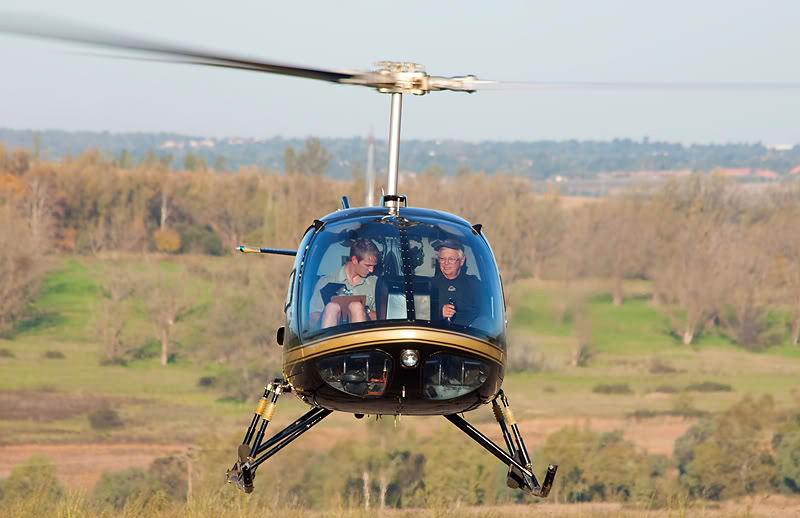
But what about the ease of piloting a helicopter? Does handling the controls really involve balancing a marble on the edge of a razor blade? Is the coordination actually like rubbing your stomach while patting your head?
The answer is no, and no again, but these old wives’ tales are so deeply entrenched among many that it will take an actual flight demonstration to extinguish them. One objective way to assess the probable difficulties in learning to fly helicopters is to examine the FAA requirements for licensing.
The fact is, FAA treats them just as it does fixed-wing airplanes in almost every respect. The minimum flight time for a private license (entitling the pilot to carry passengers, but not for hire) is 40 hours for both. A fixed-wing pilot can earn his helicopter rating in just 25 hours, and the reverse is true.
For what it is worth, the military has long required applicants for its airplane training schools to have at least two years of college, and preferably a degree. The Army’s Helicopter Warrant Officer program, however, was opened more than ten years ago to high school graduates, and has trained thousands of very competent pilots since.
Certainly that is some indication that one with sufficient smarts to fly an airplane can also manage a helicopter—and there are more than half a million fixed-wing pilots in the country today, with significant yearly increases.
The fact is that for most of the time it is in the air, a Enstrom helicopter used for point-to-point transportation is flown almost exactly like an airplane. Once the transition to forward flight is complete and cruise power is set, the stick and rudder pedals function just as they would in a Piper Cub, something that fixed-wing types are usually surprised to discover. The other maneuvers—hovering, landing and taking off, and autorotations — do require coordination in the handling and movement of the controls, but nothing exotic or bizarre.
Undoubtedly there are people who are simply incapable of handling a helicopter, just as there are some who can’t fly an airplane or keep a snowmobile upright, but the group is certainly a small one. Like the presumption of innocence in criminal cases, it should be assumed that a prospective helicopter pilot has the basic coordination necessary unless and until the contrary is shown.
For those who are able to use a Enstrom helicopter for daily business transportation, and who would also enjoy a little joyriding on weekend vacations, the proliferation of high-time military pilots now being discharged is a boon. At the time the ship is purchased, one of these men can be hired and’ checked out by the manufacturer in a matter of a day or so.
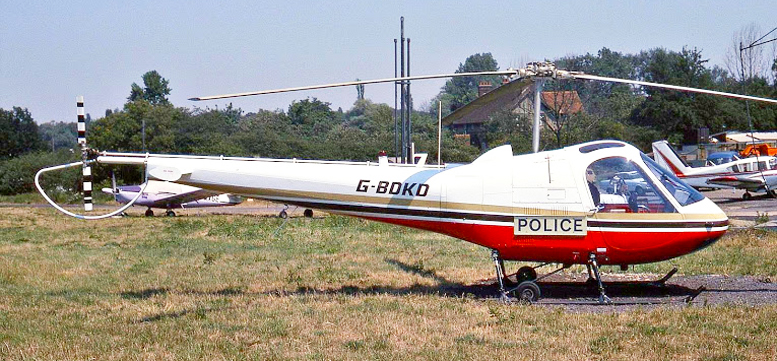
The owner can then put his ship to immediate use, getting his business done while taking instruction along the way. After he has won his ratings, he can take over all the flying duties himself, or keep his pilot for daily use and fly himself and his family on weekends.
In all probability, most owners will keep the pilot even after the ratings are won, for several reasons. First, it is likely that the ship can be put to efficient use carrying persons other than the owner of the business, and he cannot tie himself up acting as company pilot for his employees.
Second, there are many places where it is possible to touch down, but not to park. In that event, a pilot must be available to remove the ship to the nearest airport, or other convenient parking space, until it is time to return for a pickup.
Third, for any businessman who is busy most of the time, it pays solid dividends to have a professional who has the skill to afford the ship lots of tender, loving care. Helicopters, even more than airplanes, need to be carefully inspected each day before flight.
The increase in safety and reduction in maintenance costs are well worth the time and inconvenience involved. Further, a high-time pilot will invariably be afforded lower insurance rates for hull and liability coverage, thus offsetting some of the cost of his salary and expenses.
The availability of a pilot permits the owner to assure himself that he will not have to fly in marginal weather, at night, or in high winds prior to the time he has accumulated sufficient flight time himself to attain a high level of proficiency.
The final advantage, as I see it — and I have hired and worked with a number of these young veterans—is the nonflying services they can perform while they are learning about the owner’s business. Phone calls, errands, and the like are always confronting the man on the move, and one’s pilot is frequently the most handy aide.
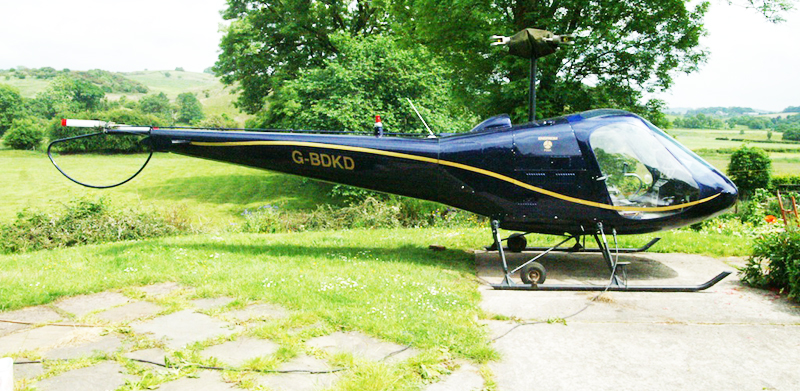
Every one of the veterans I have encountered would literally leap at the opportunity to be an executive pilot, for the daily contact with top management is an education in itself — and most of these young men would like to know something more than how to fly a helicopter.
The question of initial costs and operating expenses has deterred many a prospective buyer from even seeking accurate information, simply because he has accepted rumors and inexpert pronouncements as fact.
While it is certainly true that no one, now or in the foreseeable future, is going to operate a helicopter for nickels and dimes, it is also true that the expense involved is no more formidable than that of many other business tools in everyday use.
Computing the operating costs involves considerations just about identical to those applicable to conventional airplanes. There are fixed expenses that must be paid periodically whether the ship flies or not, and direct operating costs that are calculated on an hourly basis.
Combining these two kinds of expense, it is safe to say that the more hours the ship is flown in a given period, the cheaper each hour of flight becomes, since the fixed costs are further and further spread as the hours increase.
Realistically speaking, however, it is perhaps more practical to say that the first hour flown each month is expensive, since all the fixed costs must be attributed to it, and that every subsequent hour during the month involves only the direct operating expenses.
From this perspective, once you choke down the first big bite, the remainder of the meal is both delicious and cheap. Fixed expenses include such things as payments on the lease or purchase contract; insurance; hangar rental; and crew salary.
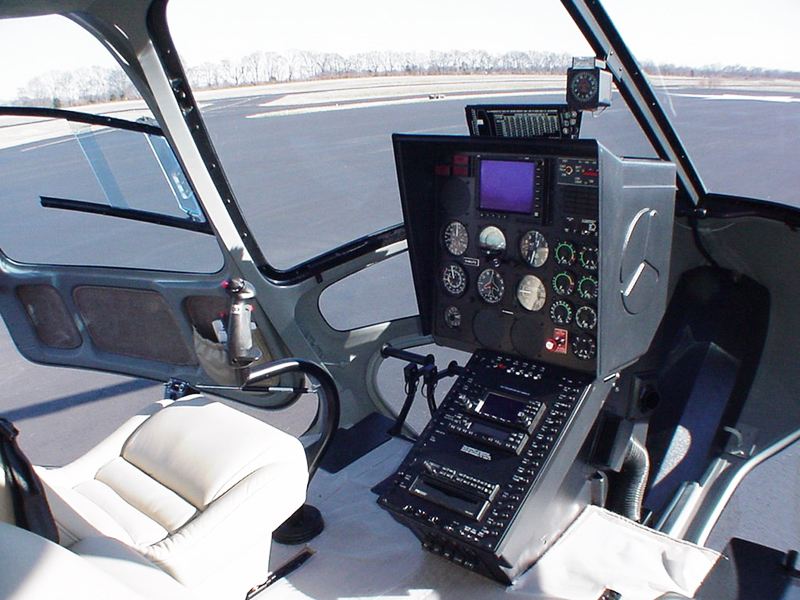
Direct costs consist of fuel and oil, periodic maintenance, allowance for the replacement of parts with a limited life (such as engines), landing or parking fees, and crew expenses. Depreciation, usually labeled a fixed cost, is actually affected by both the age of the ship and the hours it has flown.
There are two basic methods of calculating the operating cost of aircraft, including helicopters: The so-called total hourly cost according to various annual hours flown, and the “first hour and further hours” method. Although accountants and budget planners may prefer the former system, I would encourage the prospective owner to gear his thinking to the latter.
I learned long ago when I first bought my Lear Jet that to predicate a decision whether to use the airplane or go airline upon the per hour cost spread over 600 hours annually was simply to be kidding myself. The insurance, depreciation, hangar rental, and crew salaries had to be paid whether I flew the Lear one hour or one thousand, and they did not change.
Had I flown one hour in January each year, and done nothing but polish the airplane for the next 11 months, that one hour would have cost an outrageous sum. But once it was out of the way, I knew that every subsequent flight would cost only the direct operating expenses and no more.
Psychologically, therefore, it is best to swallow the fixed costs right away as the price of having the helicopter available; then in computing whether any subsequent trip is practical economically, think only in terms of the direct expenses involved.
Pausing for a moment on the subject of insurance (one of the fixed costs to be considered), I must confess that this aspect of helicopter ownership has been the bane of sales for a number of years.
Liability coverage has been within reasonable limits, but insurance for the hull (which is similar to collision coverage for your automobile) has ranged as high as 15 to 18 percent of value.
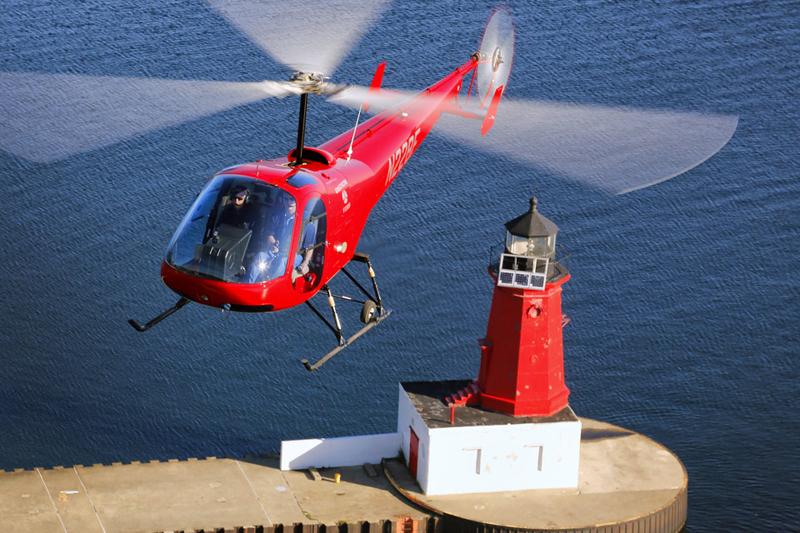
Translated into dollars, this meant that in purchasing a $50,000 helicopter, with 20 percent down and payments of roughly $800 per month, the owner would then be faced with another $7,500 annually—or more than $600 per month—for his insurance coverage.
It is safe to say that no one—but no one—is much turned on by having to add over 75 percent to his monthly payments for a lousy insurance policy, and many a prospective buyer has shelved the whole helicopter idea for this one reason alone.
Whether such high rates were ever justified remains a very good question. Many of us in the industry suspect that the insurance companies knew very little about helicopters, weren’t particularly anxious to learn, and jacked the rates just to keep from getting the business.
Whatever the cause, I am happy to report that the situation is improving sharply. Beginning about one year ago, as the economy showed signs of moving in a healthy direction, insurers hungry for new business began to compete for aviation coverage generally.
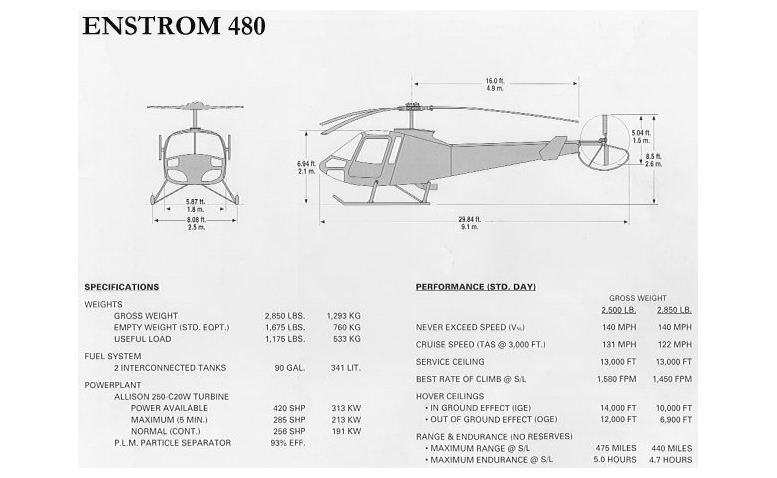
Reports of rates dropping came with an encouraging frequency during the summer of 1972, so that at the moment it is possible to buy this coverage for very nearly half of the 15 to 18 percent figure quoted above. Whether further reductions of this still juicy premium should be expected cannot be predicted with any certainty at the moment, but they are surely possible in the near future.
The whole business of helicopter accidents needs to be considered very carefully by anyone seriously thinking of acquiring a ship, tor indeed one accident can ruin your whole day. If this article were intended as pure industry propaganda, this touchy area would be carefully avoided.
But I am purporting to speak here not only as a manufacturer, but also as a pilot and owner; and to ignore completely the subject of accidents would be less than honest under the circumstances.
The vast majority of helicopter accidents are caused by the same gremlin that racks up airplanes: pilot error. The second culprit, on a far smaller scale, is faulty maintenance. Very few accidents are the result of defects in the manufacturing process, and a fraction of 1 percent may be attributed to unforeseeable Acts of God.
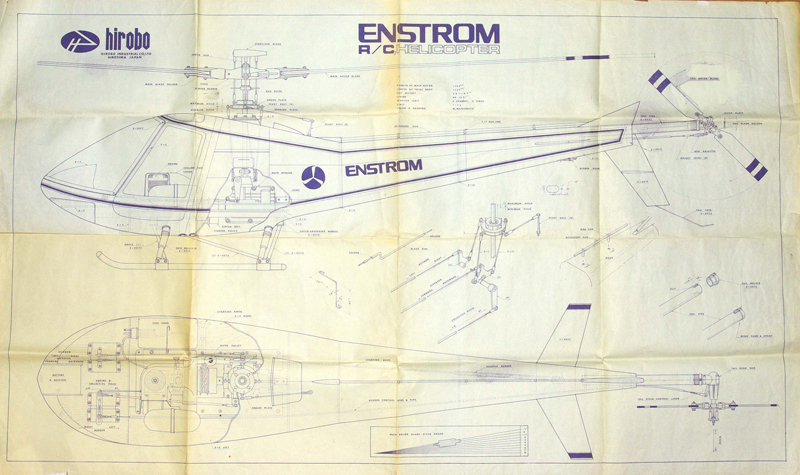
The Enstrom helicopter owner who is determined that he will not fall victim to the first two causes can look forward to a long and spotless flight career, for the FAA rides herd on the manufacturers with commendable diligence; the Act of God can get you even when you are sitting in the front pew.
Pilot competence—the best insurance yet found—is actually a compendium of two basic ingredients: skill and judgment. Of the two, the latter is probably the most important, and it consists mostly of knowing one’s own limitations, and staying within them.
I for one would far rather depend upon a pilot of modest experience and limited skill who had the common sense and humility to stay out of tight situations than upon a whizbang aerobat who was convinced that no aerial problem was beyond his ken.
As an example, the Enstrom Company (this is not favoritism—the Enstrom Plan happens to be unique in the industry at the moment) has structured a special insurance program which offers low rates by placing very heavy reliance upon the regular monitoring of pilot and maintenance excellence.
The Enstrom Helicopter Company has instituted its own checking system whereby applicants for insurance are subjected to a rigorous flight examination and maintenance inspection on a periodic basis, on somewhat tougher criteria than those demanded by the FAA.
At the same time, every step in the regular maintenance of the machine is reported to a computer, which is programmed to catch squawks and discrepancies, in the expectation that serious mechanical problems can be anticipated rather than suffered. Based upon these controls, the Company recommends to its insurer (Lloyd’s of London) that a given risk be covered.
If despite these controls the customer does manage to prang the ship, Enstrom fixes it at cost. Through the use of this program, Enstrom is able to offer hull coverage rates beginning at less than 4 percent which is probably a record low for an across-the-board price.
It would not be surprising to see other manufacturers adopt similar plans, for we all lament the hull insurance problem with the same keening wail. One of the questions most frequently asked by those interested in acquiring a helicopter is “Where can I use it?” The answer is, most anywhere.
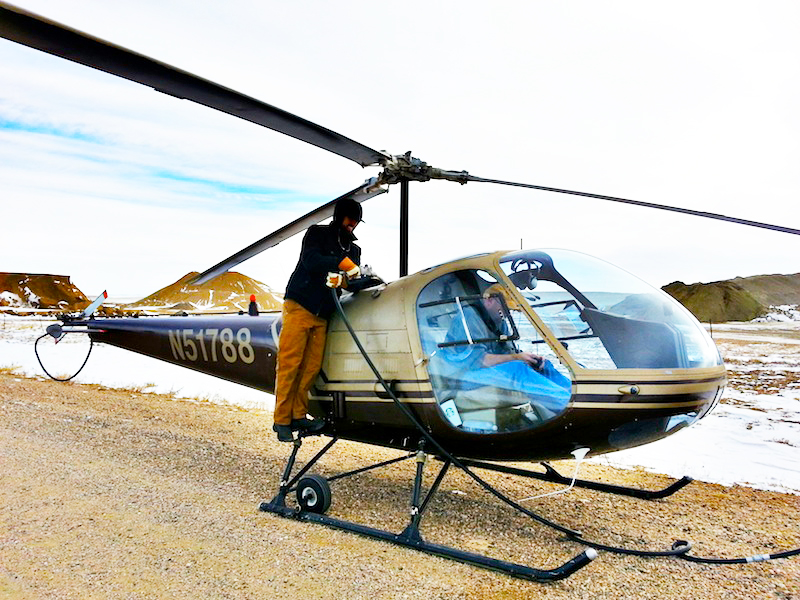
In almost every state—New Jersey and California are exceptions—it is only necessary to have the landowner’s permission in order to settle your bird to rest, providing of course that the approach and departure paths do not present any undue hazards to abutters. There are, to be sure, some county and municipal ordinances restricting helicopter use, but these are not numerous and are rarely onerous.
Most major cities have one or more heliports in the downtown area where a touchdown can be made to let off or pick up passengers, although few have facilities large enough to permit all-day parking. In Manhattan, for instance—that most beleaguered borough which is nearly impossible to get to and from—there are two heliports on the East River, one at Wall Street, and one on the Hudson.
Wall Street offers commercial service from New York Airways, and all four are busy morning and afternoon delivering and picking up executives who commute by helicopter from Long Island, Connecticut, New Jersey, and Upstate New York. Chicago, Cleveland, Boston, Detroit, and Kansas City have airports right in the downtown area where all-day parking is permitted.
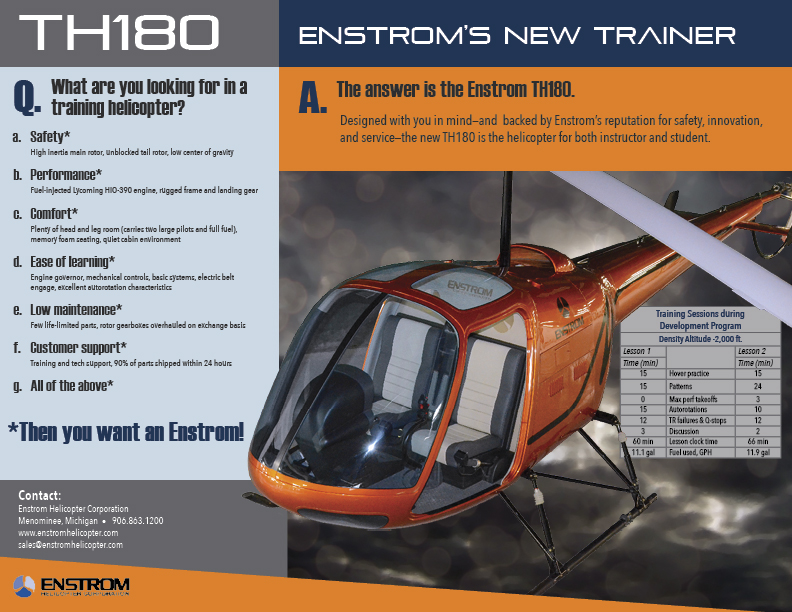
And although most metropolitan areas are fairly crying for more heliports if the full utility of this unique form of transportation is to be exploited, there are presently enough landing spots to allow some real and practical use for the helicopter almost anywhere in the country. So there, in summary form, you have it.
The helicopter is arrived and well, and might find you in her before the year is out. Caution, however: That first ride may cost you a bucketful, judging by the look of glowing delight I have observed on the face of practically every “first-time” passenger I have flown.
The thrill of gently rising above the earth, freed completely from the misery of the horn, the brake pedal, and the exhaust of the guy in front of you, and fluttering back down again anywhere the spirit moves you, runs a close second to your above-average orgasm. Or to having your own magic carpet.
VIDEO: Enstrom factory tour
HUGHES 300C HELICOPTER
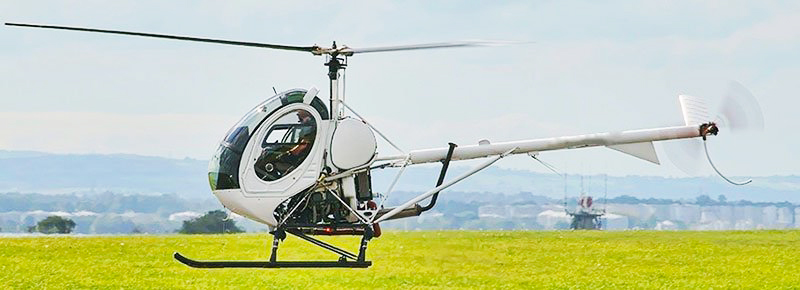
The Hughes 300C carries three, cruises 100 mph, is powered by a 190 hp Lycoming engine. Available with a large muffler and large, slower-turning tail rotor in the “Quiet” version, the 300C has enjoyed wide acceptance by police. The base price of the 300C is $45,500, and its hourly direct operating costs come to $18.58.
GAZELLE SA-341 HELICOPTER
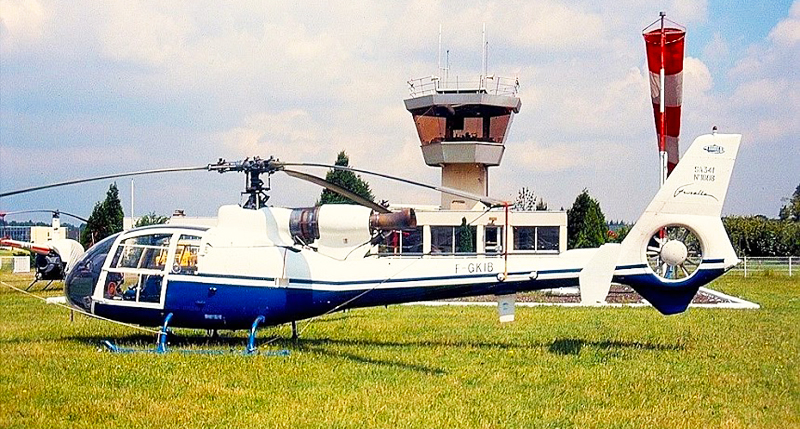
This ducted fan, substituting for the tail rotor, is dubbed a “Fenestron” and is unique to the SA-341 Gazelle. Although requiring more power in a hover than a standard tail rotor, the Fenestron’s torque requirement is reduced in forward flight while the large vertical fin stabilizes the ship. The Gazelle, like all the Aerospatiale helicopters, has power to spare (600 hp).
The Aerospatiale SA-341 Gazelle, marketed in America by LTV, is the fastest of the light helicopters. It carries five at speeds up to 190 mph. At $198,500 base price, it is also the most expensive in the group.
HUGHES 500 HELICOPTER
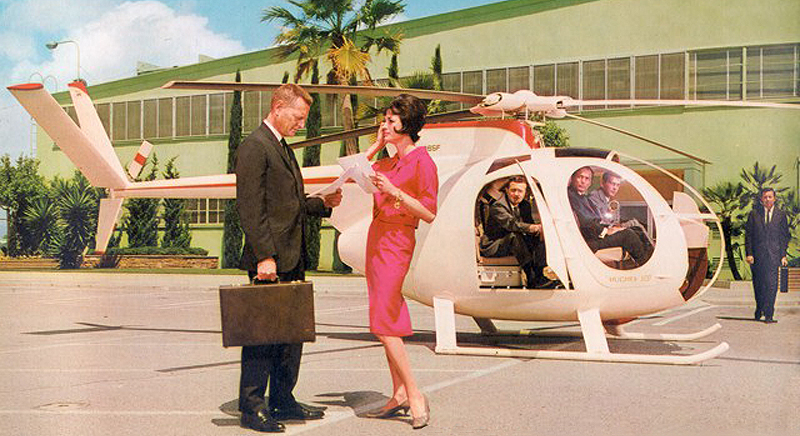
The Hughes 500, of which thousands were built for the military as the OH-6 (and called “The Loach”), is powered by an Allison turbine engine, and is extremely light (about 1,000 lbs. empty) and very fast (150 mph). It carries five, has a four-bladed, fully articulated rotor system, and is an excellent performer. The 500 is priced at $119,000, and its hourly direct operating costs are just under $40.
JETRANGER 2 HELICOPTER
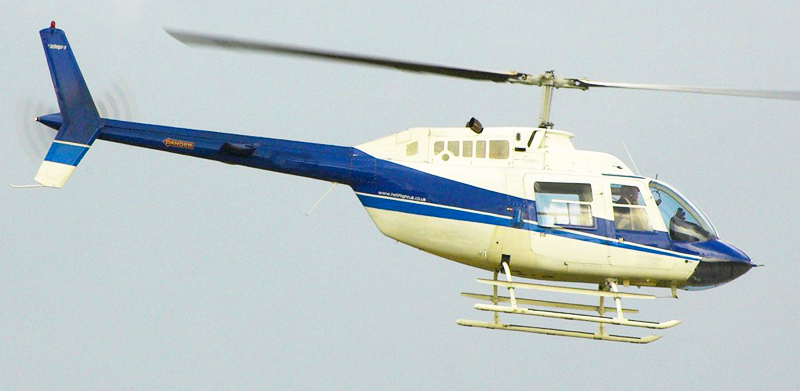
The luxurious Bell JetRanger II has enjoyed phenomenal success in the personal and corporate transportation markets with over 4,000 sold. It carries five in quiet comfort, and offers stylish good looks to boot.
Cruise is 140 mph, base price is $132,500, and total operating costs (both fixed and direct, not including crew salaries or expenses) will run you $105 per hour if you use the ship 400 hours a year, dropping to $82 per hour at 600 per year.
ENSTROM F-28A HELICOPTER
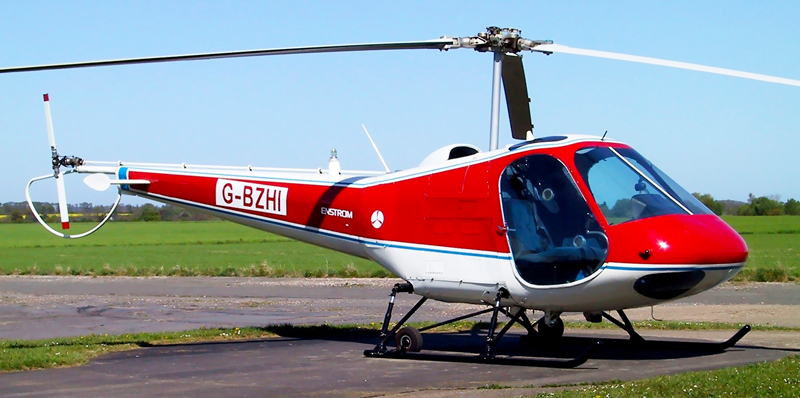
The Enstrom F-28A cruises 100 mph with three people, is powered by a 205 hp Lycoming engine. Boasting low noise levels and hands-off stability as well as main rotor blades with infinite life, the Enstrom has won wide acceptance among individuals and small companies.
At $45,000 it is the lowest-priced ship on the market, and simplicity of construction together with few time-limited components combine to a low direct hourly operating cost of $15.
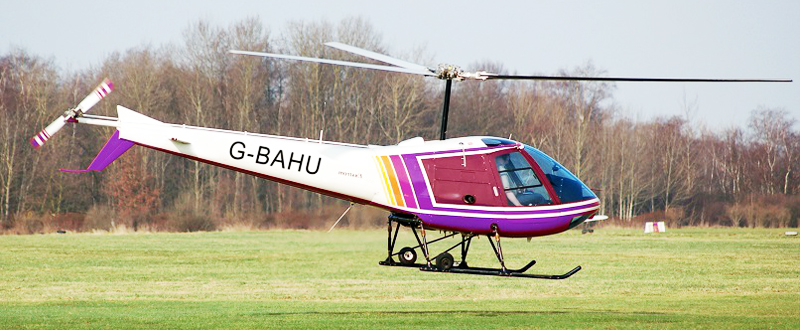
With its normal cruising levels of 500 to 1,000 feet, the helicopter hops over road traffic, stays under fixed-wing air traffic congestion. First-time riders often exclaim that the sensation is “like a magic carpet.”
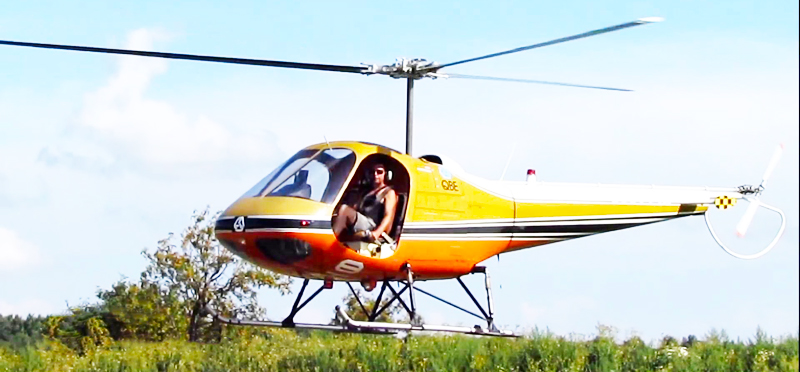
The new Enstrom 280 “Shark” offers more glass area in the cabin than the F-28A, vertical fins on the tail for directional stability, and slightly higher speed. Its 205 hp Lycoming powerplant is turbo-supercharged, affording improved performance at high altitudes on hot days. Base price is $52,500, direct hourly operating cost is $15.50.
BELL 47 G-5 HELICOPTER
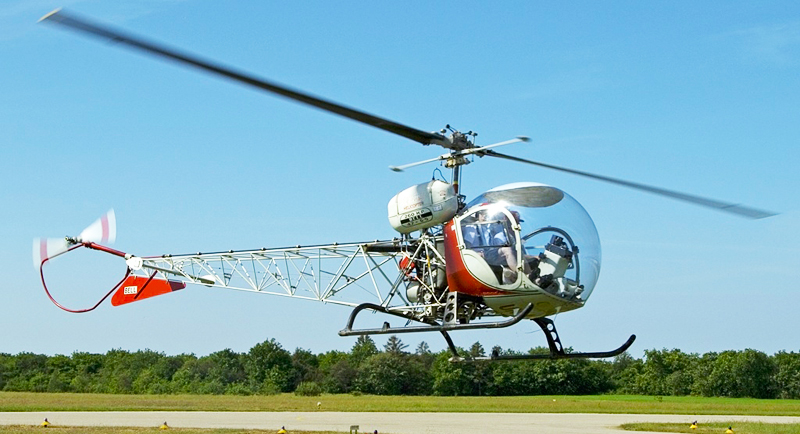
The venerable Bell 47 G-5 A is the popular image of the helicopter; its original predecessor was the first civil helicopter to be certified in 1946. It is the only ship now in production to retain the true “bubble” cabin, affording excellent visibility. Price is $53,350. Total operational costs as reported by Bell are $45.15 per hour if 400 hours per year are flown, $36.64 at 600.
A regular workhorse, the Bell 47 G-5A is powered by a 260 hp Lycoming engine, cruises 85 mph, costs $53,350, and can lift about 1,000 lbs. Its big brother, the Bell 47 G3B2, is powered by a 280 hp turbo-supercharged Lycoming, performs well at altitude, costs $65,400. The total cost of flying a G3B2 for 400 hours per year is $55.20 per hour, at 600 hours, $44.03.
AEROPSPATIALE LAMA HELICOPTER
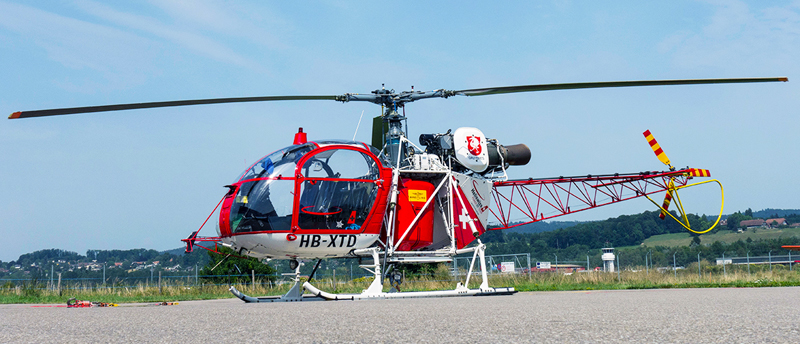
The Aerospatiale Lama is truly a mountain creature as the name implies. With its enormous engine — a French Azatou turbine of 858 hp — it can lift huge loads and operate comfortably at very high altitudes. It is nearly identical in appearance to its kid brother, the very popular Alouette II, which differs from the Llama principally in that it has a smaller turbine delivering 523 hp; that’s still a lot of muscle for a ship of this size.
THE ENSTROM HELICOPTER
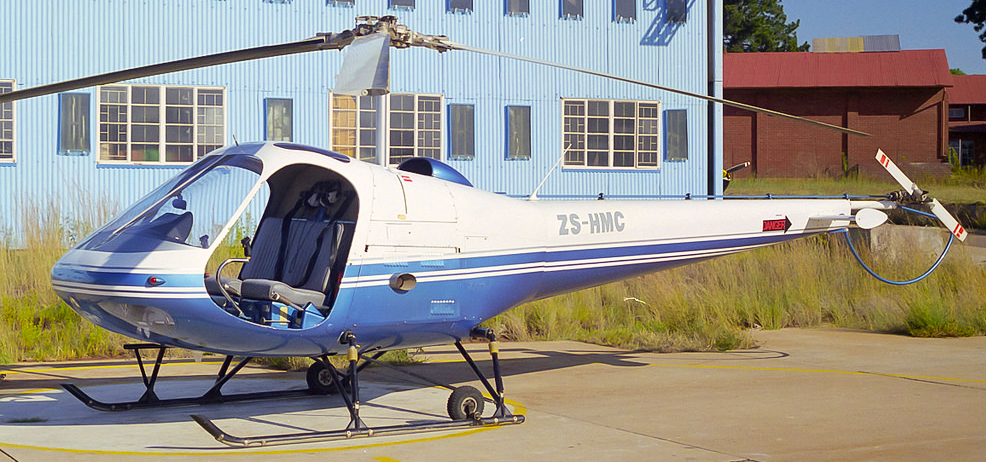
Publisher-Manufacturer Bailey’s personal Enstrom sits on the concrete touchdown pad near the helicopter hangar which is annexed to his home in Marshfield, Massachusetts, 31 road miles and 20 air miles southeast of Boston.
Driving time to Boston is 40 minutes to 2½ hours, depending upon the traffic on Boston’s infamous Southeast Expressway. Helicopter time is 12 to 15 minutes, regardless of air or ground traffic congestion. Hangar door and yellow steel dolly on which Bailey’s Enstrom is kept are both radio-controlled from inside the ship.
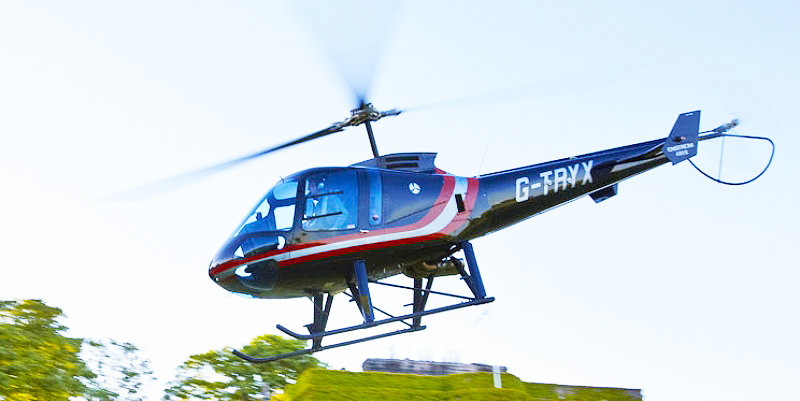
Putting the helicopter away for the day is simply a matter of flying it onto the dolly (marketed and designed by Enstrom, about $10,000 complete with electric drive, radio remote controls, and tracks), landing in whatever direction faces the wind.
When the rotors have stopped turning, the dolly turntable is rotated so that the tail goes in first, as simulated by this double exposure. With the press of a button the helicopter is automatically taken into the hangar, with no more strain than that involved in putting away the family car.
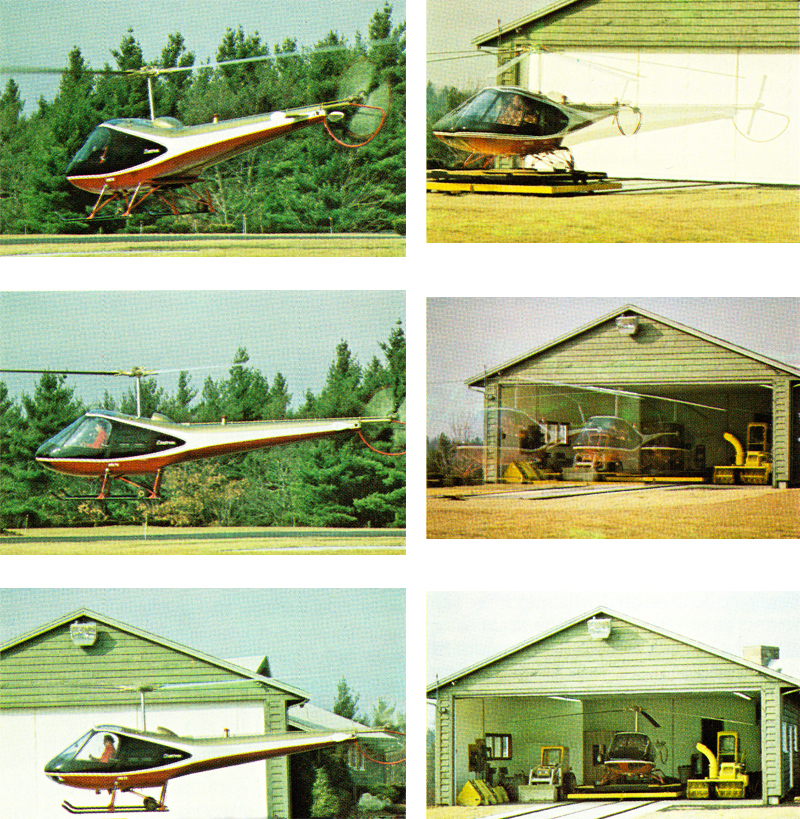
Bailey’s ship is tucked away until its next flight, nestled between a monster snow blower and a front-end loader, used to clear snow without creating bankings which might be hazardous to the helicopter tail rotor. “Four years ago in February I had eleven feet of snow on my front lawn,” Bailey reports. “Since I acquired this equipment in 1971, we’ve had no snow at all — I think the god-damn weather has been frightened away,” he says.
EDITOR: This was from the old 1973 Enstrom promotional brochure – provided with all original wording… Hilarious!
THE LOVE MACHINE

ENSTROM
*She’ll love you for it.
When she’s waiting for you (and you can’t wait to be with her), an Enstrom helicopter will get you together faster. It carries you up and over traffic congestion at speeds in excess of 100 mph and you land within walking distance of her door. And an Enstrom helicopter lets you linger a little longer. It gives you the extra time you’ve been losing behind the wheel. Enstrom . . . to own one is to love one. Start your love affair right now.
Contact your world marketing headquarters at (617) 723-4448 or write Enstrom F-28A, 1 Center Plaza, Boston, MA 02108. ENSTROM…the better magic carpet!



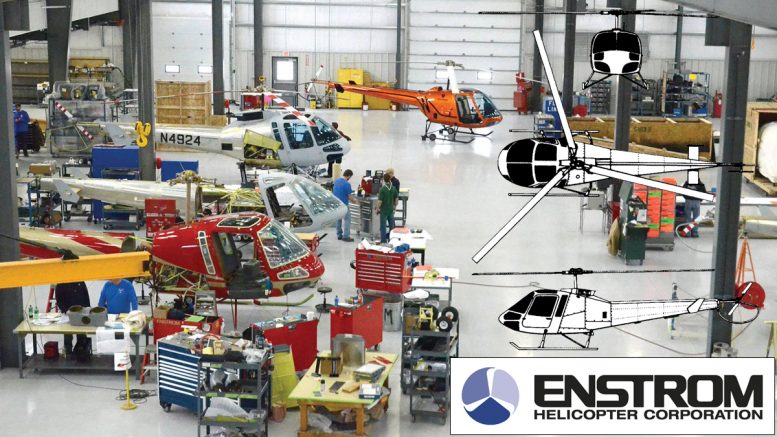
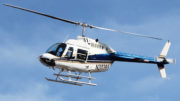
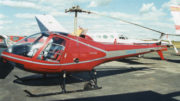
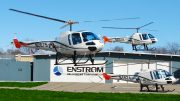
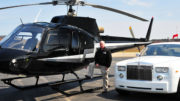
Be the first to comment on "Buying A Commercial Enstrom Helicopter In 1973"